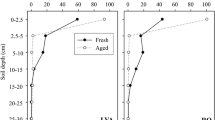Abstract
Temperature is a major environmental factor influencing land surface volatilization at the time of agricultural field fumigation. Cooler fumigation soil temperatures relevant to Pacific Northwest (PNW) application practices with metam sodium/potassium should result in appreciably reduced methyl isothiocyanate (MITC) emission rates, thus minimizing off target movement and bystander inhalation exposure. Herein, a series of laboratory controlled flow-through soil column assessments were performed evaluating MITC emissions over the range of cooler temperatures (2–13°C). Assessments were also conducted at the maximum allowed label application temperature of 32°C. All assessments were conducted at registration label-specified field moisture capacity, and no more than 50% cumulative MITC loss was observed over the 2-day post-fumigation timeframe. Three-fold reductions in MITC peak fluxes at cooler PNW application temperatures were observed compared to the label maximum temperature. This study supports current EPA metam sodium/potassium label language that indicates surface fumigations during warmer soil conditions should be discouraged.



Similar content being viewed by others
References
CAL EPA (1994) Report EH 94–02: air monitoring for methyl isothiocyanate during a sprinkler application of metam-sodium. CAL EPA, Dep Pestic Regul Sacramento CA 94–02
Gan J, Yates SR, Wang D, Spencer WF (1996) Effect of soil factors on methyl bromide volatilization after soil application. Environ Sci Technol 30(5):1629–1636
Gan J, Yates SR, Papiernik S, Crowley D (1998) Application of organic amendments to reduce volatile pesticide emissions from soil. Environ Sci Technol 32(20):3094–3098
Gan J, Papiernik SK, Yates SR, Jury WA (1999) Temperature and moisture effects of fumigant degradation in soil. J Environ Qual (28):1436–1441
Grube A, Donaldson D, Kiely T (2011) Pesticides industry sales and usage: 2006 and 2007 market estimates. US EPA, Office of Chemical Safety and Pollution Prevention, Office of Pesticide Programs, Biological and Economic Analysis Division, Washington, DC. https://www.epa.gov/pesticides/pesticides-industry-sales-and-usage-2006-and-2007-market-estimates
Leistra M, Crum SJH (1990) Emission of methyl isothiocyanate to the air after application of metham-sodium to greenhouse soil. Water Air Soil Pollut 50:109–121
LePage J, Gross A, Hebert VR (2009) 2008 MITC residential community air assessment; Franklin County, Washington. Washington State Department of Health tech report. http://www.doh.wa.gov/portals/1/documents/4300/pesticide-wsu-mitc-residentialreport2008.pdf
Littke MH, LePage J, Sullivan DA, Hebert VR (2012) Comparison of field methyl isothiocyanate flux following Pacific Northwest surface-applied and ground incorporated fumigation practices. Pest Manag Sci 69:620–626
Ma QL, Gan J, Papiernik SK, Becker JO, Yates SR (2001) Degradation of soil fumigants as affected by initial concentration and temperature. J Environ Qual 30:1278–1286
Merriman J, Hebert VR (2007) Methyl isothiocyanate residential community air assessment; South Franklin County, Washington. Bull Environ Contam Toxicol 78(1):17–21
Simpson CR, Nelson SD, Stratmann JE, Ajwa HA (2010) Surface water seal application to minimize volatilization loss of methyl isothiocyanate from soil columns. Pest Manage Sci 66(6):686–692
Smelt JH, Leistra M (1974) Conversion of metham-sodium to methyl isothiocyanate and basic data on the behavior of methyl isothiocyanate in soil. Pestic Sci 5:401–407
Sullivan DA, Holdsworth MT, Hlinka DJ (2004) Control of off-gassing rates of methyl isothiocyanate from the application of metam-sodium by chemigation and shank injection. Atmos Environ 38:2457–2470
US EPA (2009) Amended reregistration eligibility decision (RED) for methyldithiocarbamate salts-metam sodium/potassium and MITC, accessible at Amended reregistration eligibility decision (RED) for methyldithiocarbamate salts-metam sodium/potassium and MITC. http://nepis.epa.gov/Exe/ZyNET.exe/P1004V9Z.TXT?ZyActionD=ZyDocument&Client=EPA&Index=2006+Thru+2010&Docs=&Query=&Time=&EndTime=&SearchMethod=1&TocRest
US EPA (2013) Latest label of Sectagon-42® (42.2 % solution of metam sodium). http://www3.epa.gov/pesticides/chem_search/ppls/061842-00006-20130924.pdf
Van den Berg F (1992) Measured and computed concentrations of methyl isothiocyanate in the air around fumigated fields. Atmos Environ 27A:63–71
Van den Berg F, Smelt JH, Boesten JJTI, Teunissen W (1999) Volatilization of methyl isothiocyanate from soil after application of metam-sodium with two techniques. J Environ Qual 28:918–928
WDOH (2009) Methyl isothiocyanate air monitoring in south Franklin County Washington. http://www.doh.wa.gov/DataandStatisticalReports/EnvironmentalHealth/Pesticides/AirMonitoringStudy
Woodrow JE, Seiber JN, Dary C (2001) Predicting pesticide emissions and downwind concentrations using correlations with estimated vapor pressures. J Agric Food Chem 49(8):3841–3846
Woodrow JE, LePage JT, Miller GC, Hebert VR (2014) Determination of methyl isocyanate in outdoor residential air near metam-sodium soil fumigations. J Agric Food Chem 62:8921–8927
Zheng W, Yates SR, Papiernik SK, Nunez J (2006) Conversion of metam sodium and emission of fumigant from soil columns. Atmos Environ 40:7046–7056
Acknowledgements
The authors are grateful for support from the Washington State Potato Commission, Oregon Potato Commission, Washington State Commission on Pesticide Registrations and product support from Tessenderlo Kerley. We are grateful to Steve Jordan from the Department of Engineering, Washington State University Tri Cities in constructing soil columns. We also wish to acknowledge the technical support of Jane LePage and Wade Carter of Washington State University Tri Cities.
Author information
Authors and Affiliations
Corresponding author
Rights and permissions
About this article
Cite this article
Lu, Z., Hebert, V.R. & Miller, G.C. Laboratory Measured Emission Losses of Methyl Isothiocyanate at Pacific Northwest Soil Surface Fumigation Temperatures. Bull Environ Contam Toxicol 98, 257–261 (2017). https://doi.org/10.1007/s00128-016-1993-2
Received:
Accepted:
Published:
Issue Date:
DOI: https://doi.org/10.1007/s00128-016-1993-2




